Thread subject: Diptera.info :: Biblio marci / hortulanus
Posted by Robert Heemskerk on 23-10-2005 11:12
#1
Hi fly-readers,
Yesterday I saw a group (~50-100) of black flies dancing around a dead tree(Dunes/Holland).
They stood still in the air with the (quite long) legs hanging downward.
I couldn't see any difference in these flies, they all looked quite similar.
The flies were black and the wings were very white. Fly-size ~10mm
It could be a group of (only male!) flies of Biblio marci or Biblio hortulanus, the female flies look more different in these species.
Are there fly-species which look similar to this kind of flies or what kind of fly must I think of?
Biblio m. + h. usualy fly from March and April, it is not the time to fly now?
I made a picture of one fly, not a very good one, but you can see some of it.
best regards, Robert
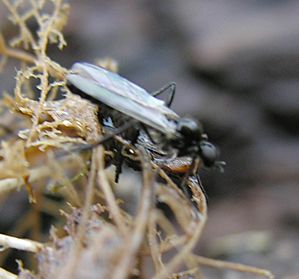
Edited by Robert Heemskerk on 23-10-2005 12:53
Posted by Andre on 23-10-2005 12:23
#2
This probably is Dilophus femoratus, a Bibionid flie indeed. It is much smaller than Bibio marci and hortulanus. Definite identification can be made on a collected specimen (ask Theo or Laurens for example).
Greetzz
Posted by Mark van Veen on 23-10-2005 14:35
#3
Op waarneming.nl staat een plaatje van D. femoratus met kenmerken:
http://www.waarne...hp?id=6358.
Mogelijk helpt dat. Als je vrouwtjes goed gezien hebt: hadden ze rode dijen? Dat sluit namelijk de gewone koortsvlieg, D. febrilis, uit.
Mark
Posted by Robert Heemskerk on 23-10-2005 15:01
#4
Yes, I think it where Dilophus femoratus or Dilophus febrilis.
I did not see red on the legs, but I did not give attention to this.
Indeed, this flies were to small for Biblio marci / hortulanus!
To be sure I have to visit them again I think...
Maybe I will visit the place again next week.
Thanks a lot for your comment!
Posted by Zeegers on 23-10-2005 17:33
#5
Sorry to spoil the party, but I disagree.
There is now way to be sure, but given the picture and the size it is most likely Bibio clavipes (or lepidus).
Arguments: size (too large for Dilophus), longer hairs on thorax and the costa seems to be light near the wing tip (not so in Dilophus).
Where the hack did I find those features:
See link section (my field key to Bibionidae on homepage Louis Boumans, thanks Louis).
Did you collect some specimen ?
Bibio clavipes would be a nice find !
Theo Zeegers
Posted by Robert Heemskerk on 23-10-2005 22:16
#6
Ik heb de balonnen en slingers weer opgeruimt hoor!
Drankjes zijn in de koeling teruggezet..,
Als het morgen een beetje weer is ga ik nog een poging wagen en goed op de Bibionidae-kenmerken letten. Nu maar hopen dat ze er nog zitten.
Bedankt voor de zwarte-vliegenlink!, en nog in het Nederlands ook.., dat is fijn.
:)
groet, Robert Heemskerk
TRANSLATION:
I cleaned up the party decoration!
Drinks are back in the fridge.
If the weather improves tomorrow I will have another go at them and will pay attention to Bibionidae characters. Let's hope they're still there.
Thanks for the March fly link! And in Dutch, too..., that's nice.
Edited by Paul Beuk on 24-10-2005 21:20
Posted by Andre on 23-10-2005 23:53
#7
Nee Robert, dan ook graag een paar v?ngen.. :)
P.S.: Theo, ontwaar ik daar een doornenkrans om tibia I?
TRANSLATION:
Nr, Robert, you shuld catch a few!
P.S. Theo, are those spines on tibia !?
Edited by Paul Beuk on 24-10-2005 21:21
Posted by Robert Heemskerk on 24-10-2005 00:03
#8
V?ngen!?..:o..., dan moet ik me eerst verdiepen in wat ze eten en hoe ik ze in leven moet houden!
TRANSLATION:
Catch them!?..:o.., then I will have to find out what they eat and how to keep them alive!
Edited by Paul Beuk on 24-10-2005 21:22
Posted by Zeegers on 24-10-2005 09:32
#9
Andre is right !
If you look very closely, you can see a row of spines in the middle of tibia 1. Out of focus, but it is there.
This means it is a Dilophus after all.
Three species are candidate: there is no way to tell which it might be.
Unfortunately, since all three have been recorded from the dune area.
The size (about 10 mm.) is most likely somewhat exaggerated.
Theo
Posted by Robert Heemskerk on 24-10-2005 11:33
#10
Yes, it look likes spines.
I place a detail of it.
No flies today, to much rain! :(
Robert
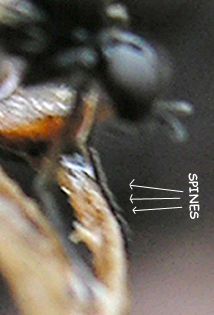
Posted by Paul Beuk on 24-10-2005 12:06
#11
What you point out here, actually, appear to me as the tips of the tarsal segments...
Posted by Robert Heemskerk on 24-10-2005 12:39
#12
:( mmmm, I think the picture is too bad to see these things and must give up!
Since so far I didn't know anything about such flies, nice species!
Robert,
Posted by Andre on 24-10-2005 13:54
#13
Please catch one Robert... we will kill them for you ;)
Posted by Zeegers on 24-10-2005 20:40
#14
I was talking about the RIGHT frontal leg.
There you can see some structures that may be the Dilophus-spines.
Theo
Posted by Paul Beuk on 24-10-2005 21:24
#15
Hey guys, please keep the English up and not switch to Dutch. There are still people how do not understand Dutch (do not ask me why, though :p).
Posted by Andre on 25-10-2005 00:14
#16
Thank you, dearest Paul, for translating :) thumbsup!
Posted by Paul Beuk on 25-10-2005 07:08
#17
Andre wrote:
Thank you, dearest Paul, for translating :) thumbsup!
Wel, you have to take some drastic measures if the non-Dutch speaking members raise there voices (albeit off-line). :p
Posted by Andre on 26-10-2005 10:43
#18
The weather will be fine tomorrow Robert :p
Posted by Robert Heemskerk on 26-10-2005 12:36
#19
Today I tried to get the car, but I could not get it! (I have to borrow it..)
I have to try it tomorrow again.., but that's my father's birthday:o
And when I find these fly, I try to catch one (I will shut my eyes:@)
What will happen to this fly?
Could it by useful for scientific study?
regards Robert,
Posted by Andre on 26-10-2005 23:18
#20
If you want, you can bring it to the ZMA, Plantage Middenlaan 64.
Try to catch two or three... Put them in an empty photofilm-box. Write your name on it, the day and place where you caught them too.
Address it to Theo Zeegers and it will get on the right place.
Succes!
Greetings, Andr
Posted by Robert Heemskerk on 27-10-2005 18:18
#21
I catched 3 flies, but one escaped(!?).
Do not know how but there are two left.., and I will bring them tomorrow to the lab (Theo Z.)
regards, Robert heemskerk:)
Posted by Andre on 27-10-2005 18:34
#22
So you caught 2 flies? :)
While you keep them (are they dead now? let them dry and keep them dry), maybe you can make some extreme close-ups for us, the viewers? Please make a very close picture of the spines of the frontal tibia. And please a picture where we can see the color of the legs and of the hairs on abdomen and thorax (a good picture from the side will do).
:)
Edited by Andre on 27-10-2005 18:34
Posted by Robert Heemskerk on 27-10-2005 18:55
#23
The size is less then 10mm, now I count 7-8mm and with my magnifying glass I see a lot of hair on the thorax, on the first legg I see one strong/long (end)spine which is coloured (brown/red).
Today I made one picture which is a little bit better then the first one, it was difficult to find one today. I saw a lot of them flying (~100)
Tomorrow I make another picture (I hope better)
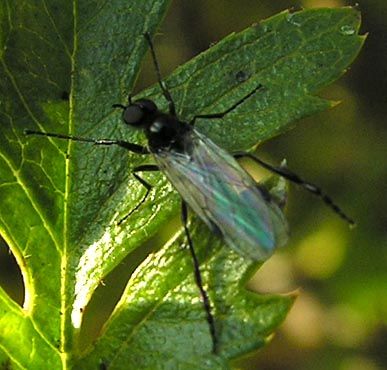
Edited by Robert Heemskerk on 27-10-2005 21:16
Posted by Laurens van der Leij on 27-10-2005 21:40
#24
Definitely a Bibio spec.! Probably B. lepidus or B. clavipes. Both are autumn species.
Posted by Paul Beuk on 27-10-2005 21:56
#25
IMO they may just as well be the same species...
Posted by Zeegers on 28-10-2005 07:51
#26
Congratulations again.
I agree with Laurens: Bibio clavipes (or lepidus).
IN agreement with my first ID.
Theo Zeegers
Posted by Robert Heemskerk on 28-10-2005 11:23
#27
This is a picture with more details..
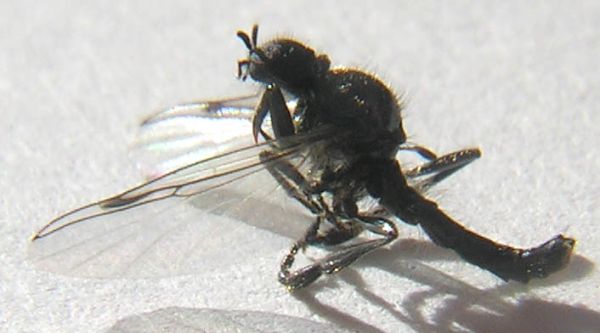
Posted by Robert Heemskerk on 28-10-2005 13:00
#28
another viewon the front leg.
Legs seems to be black!, the long strong spine on the frontal leg looks a little red/braun.
This afternoon I brought the fly to the ZMA-lab, Theo can tell more soon I think.
regards Robert Heemskerk,
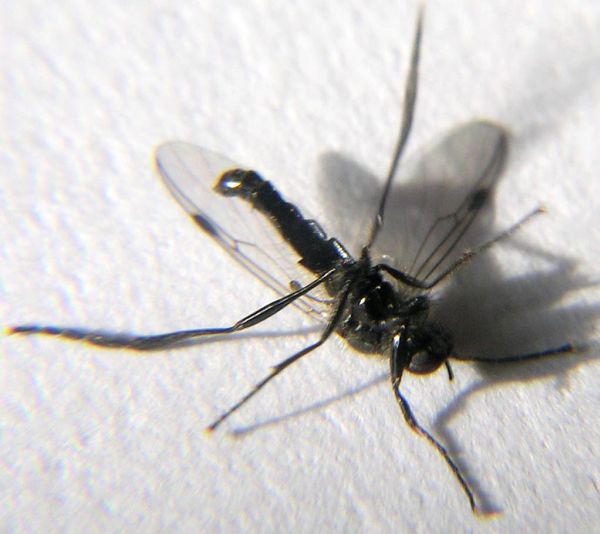
Edited by Robert Heemskerk on 29-10-2005 14:13
Posted by Zeegers on 30-10-2005 11:18
#29
Hi Robert,
Your last posts removed all doubts: male Bibio clavipes.
You can see
* the terminal spine on tibia 1 (-> Bibio)
* the typical slender base of femur 3 (-> clavipes or lepidus)
* the stigma which does not enter the costal cell (9-> clavipes)
Why are you so bothered about the black legs ?
Legs are black in clavipes.
Thanks
Theo




